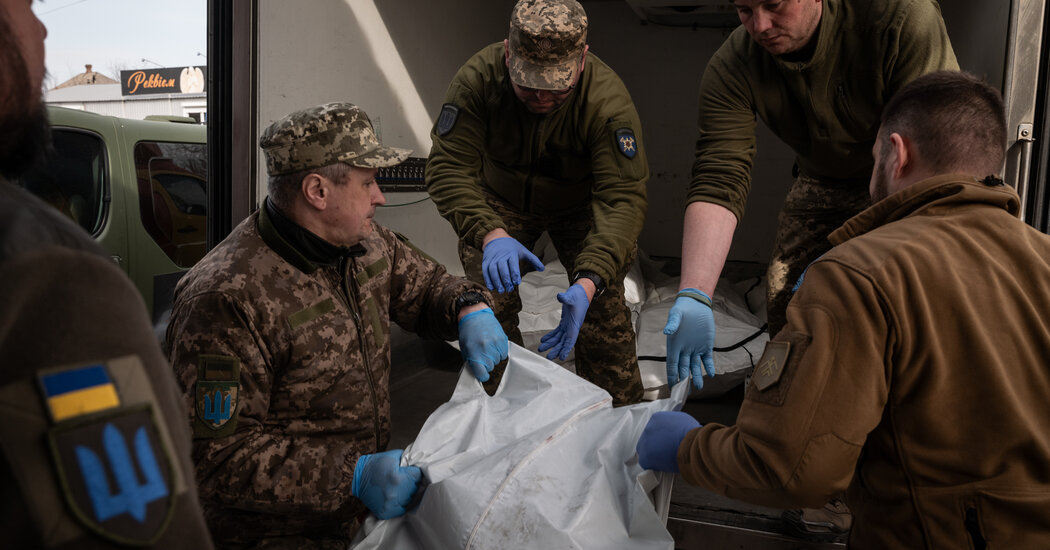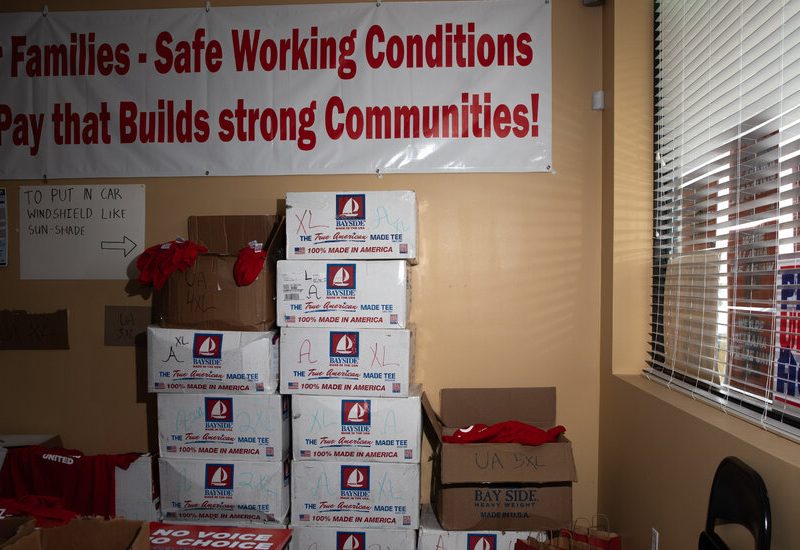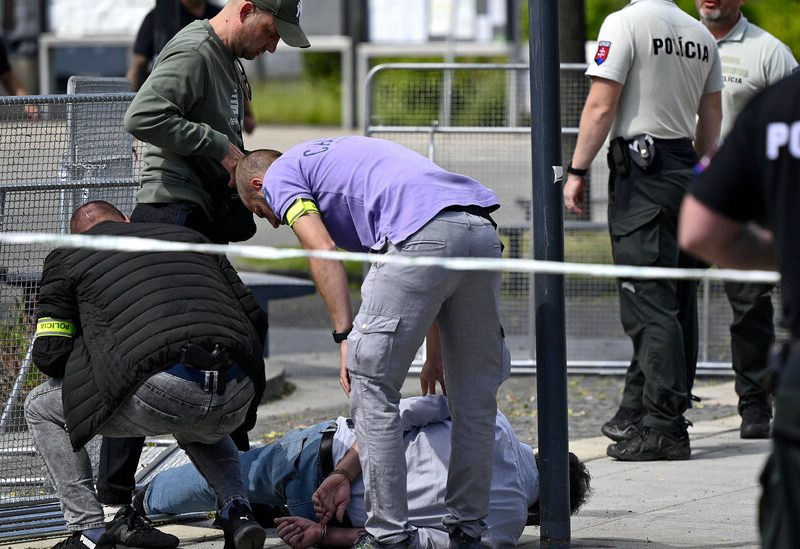The bodies of the two Ukrainian soldiers lay motionless in a field for months. Around them were bloodstains and their rifles.
The soldiers’ relatives identified their bodies from aerial footage gathered by drone. Though excruciating to watch, it seemed clear: The two men — Pvt. Serhiy Matsiuk and Pvt. Andriy Zaretsky — were dead. Yet more than four months later, the Ukrainian military still lists them as missing, even though subsequent drone footage provided by a fellow soldier weeks later showed them still lying there.
“I want to have his grave where I can come and cry all this out properly,” said Private Zaretsky’s wife, Anastasia, 31, who has been looking for closure since he was killed in November in the Zaporizhzhia region in Ukraine’s south.
This confusion, and the lengthy, difficult process of obtaining official declaration of the deaths, is far from isolated, and has emerged as another painful consequence of the two-year-old war.
Families, lawyers and rights groups say that the Ukrainian military is simply overloaded with casualties and unable to account for thousands of the dead, adding to the anguish of soldiers’ families.
Relatives of the two men in the field said that as far as they know, the bodies are still laying on the ground in the Zaporizhzhia region in Ukraine’s south.
The Ukrainian government does not disclose the number of soldiers missing in action. President Volodymyr Zelensky put the number of soldiers killed at 31,000 in February, and Kyiv has said that about half again as many are missing. (The U.S. estimates of deaths are far higher, suggesting that by last August, 70,000 Ukrainian soldiers had died.)
The high number of missing soldiers underscores the nature of the ubiquitous trench fighting, which often leaves bodies from both sides abandoned in great numbers in buffer areas between the armies, muddying the picture of the war’s toll.
Some of the missing soldiers from this war have been captured by Russian troops, but others may be dead and unidentified, lying in morgues as the government struggles to work through the backlog and figure out who they are.
The ballooning figure of missing troops is a blow to Ukraine’s already battered morale, said Ben Barry, a senior fellow for land warfare at the London-based International Institute for Strategic Studies. “They just pile the pressure on Ukrainian society and pile the pressure on the military leadership and President Zelensky,” he said. “It’s a terrible problem.”
Frustration among civilians has mounted over the lack of answers, and has occasionally burst into public view. There was a big protest in Kyiv last October, and subsequent ones in recent months, with relatives demanding more accountability for soldiers who had gone missing.
Ukrainian officials estimate the numbers of soldiers in Russian captivity at hundreds, perhaps thousands, but say that it is hard to know because Russia does not release lists of prisoners of war. In almost every prisoner exchange, they say, Russia releases some soldiers whom Ukraine had listed as missing in action — sometimes as many as one in five.
Confirming a death is particularly problematic when Ukrainian officials do not have a body, but it can be a long and difficult process even when they do.
Ideally, the Ukrainian military would have compiled a central genetic database drawn from the bodies of the dead and families of the missing, according to the International Commission on Missing Persons, a group based in The Hague that helps governments search across borders.
Petro Yatsenko, a spokesman for the Coordinating Headquarters for the Treatment of Prisoners of War, said one difficulty was that many families were reluctant to submit DNA samples while holding out hope their loved ones were still alive.
But the government’s testing is also piecemeal. Although Ukraine has 13 DNA laboratories working, the process of identifying a body can still take up to several months, said Artur Dobroserdov, Ukraine’s commissioner for missing persons.
To circumvent that bureaucracy, relatives have stepped in. They travel from morgue to morgue, sometimes aided by volunteers, looking at bodies and trying to identify them first by photographs, then later by asking relevant family members for genetic samples.
Tetiana Fefchak, a lawyer from western Ukraine, frequently goes to morgues to try to identify bodies, saying she finds that process more efficient than waiting for official declarations. “What do you suggest? For them to rot in there?” she said. “If you can do something yourself, do it.”
A law passed in 2022 was supposed to streamline identifications by allowing soldiers to donate genetic samples in advance of deployments. But the process is going “slower than we would want it to,” said a senior Ukrainian military officer familiar with it, speaking on the condition of anonymity to discuss an internal matter.
Relatives and advocates for the missing say poor communication from military commanders can sometimes make matters worse.
Private Zaretsky’s wife said the brigade commander did not reach out to the family. “Another lad, who stayed alive, took the big risk of telling me the story of how my husband died when commanders did not,” said Ms. Zaretska. “I understand that there are many deaths but it doesn’t give them the right to treat our family members like this.”
Under Ukrainian military rules, combat commanders are not obliged to speak with family members about the missing, said Mr. Yatsenko, the spokesman. The Ministry of Defense, he said, keeps maps of Ukrainian remains on the battlefield between the trenches, in the hopes of retrieving them when the lines shift.
Earlier in the war, the army accepted witness accounts of a death from other soldiers. But mistakes repeatedly emerged. “During a heavy battle, some soldier might lose consciousness, his comrades think he died, and Russians find him later,” said Olena Bieliachkova, who works for a Ukrainian group aiding families of missing soldiers or prisoners of war.
As a result, Ukraine’s military now insists on lengthy investigations of suspected deaths, meaning families can live with agonizing uncertainty for months. For families, there is a financial consideration to the delays, as well as an emotional one; relatives of fallen soldiers receive 15 million hryvnia, or about $386,000, paid in installments.
A soldier’s relatives can go to court with evidence of a death to try to get official confirmation, but this process requires a military commission to investigate each case, which takes from two to six months.
Delays only add to the cash-strapped government’s financial burden because families of soldiers who are missing, even if presumed dead, receive monthly salaries of about 100,000 hryvnia, or about $2,570, until the soldiers are officially declared dead. The cost of continuing those payments could run to potentially hundreds of millions.
The closest historic similarities to Ukraine’s predicament hearken back to the World Wars of the 20th century, where finding and identifying soldiers missing in action still continues to this day.
As the war drags on, families are becoming more desperate. Alyona Bondar’s brother has been missing since September.
“I feel a very careless attitude, no one says anything, no one is looking for him,” said Ms. Bondar, 37. In her despair, she sought help from a fortune teller, who told her that her brother had survived. “But should I believe it?” she asked.
The families of Private Zaretsky and Private Matsiuk, the two soldiers lying in the field, learned about their fate from their friend Mykola, who survived.
The two men were picking up soldiers to be driven away from the front last October, said Mykola, who asked to be identified by only his first name in keeping with military protocol. But while driving back, their vehicle broke down. They clambered out and ran.
They were behind the others when a guided antitank missile exploded nearby, and they fell in the field.
After Mykola reached the safety of Ukrainian trenches, fellow soldiers flew a drone over his friends’ bodies. They were lying still, clearly dead. Mykola said he had returned the next day to try to pull them to a Ukrainian trench. He was wounded by shrapnel and is now partially paralyzed.
“It was very important for me to bring their bodies back,” he said. “For a year we were together and ate from one plate, they would do the same for me. I just feel the need to at least bury them.”
Thomas Gibbons-Neff contributed reporting.



